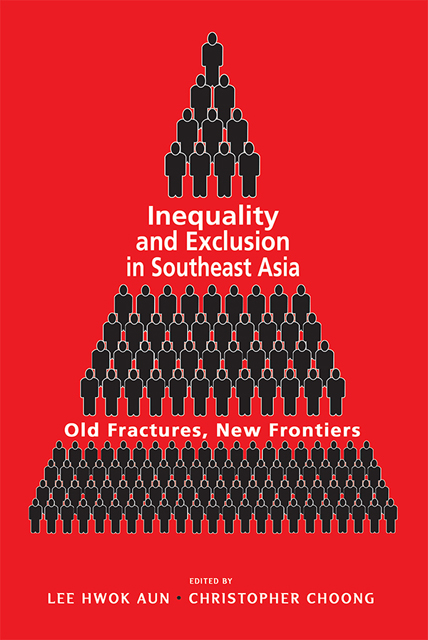Book contents
- Frontmatter
- Contents
- List of Tables
- List of Figures
- Acknowledgements
- About the Contributors
- 1 Introduction: Inequality and Exclusion in Southeast Asia
- 2 Cambodia’s Experiences in Addressing Inequality
- 3 Inequality and Exclusion in Post-Soeharto Indonesia
- 4 Inequality and Exclusion in Malaysia: Macro Trends, Labour Market Dynamics and Gender Dimensions
- 5 Inequality in Myanmar: Structural Change, Policy Outcomes and Gender Dimensions
- 6 Structural Inequality in the Philippines: Oligarchy, Economic Transformation and Current Challenges to Development
- 7 Inequality and the Social Compact in Singapore: Macro Trends vs Lived Inequalities
- 8 Inequality in Thailand: Income, Socio-economic and Wealth Dimensions
- 9 Trends and Drivers of Inequality in Vietnam
- 10 Conclusion: Old Fractures and New Frontiers
- Index
9 - Trends and Drivers of Inequality in Vietnam
Published online by Cambridge University Press: 01 September 2023
- Frontmatter
- Contents
- List of Tables
- List of Figures
- Acknowledgements
- About the Contributors
- 1 Introduction: Inequality and Exclusion in Southeast Asia
- 2 Cambodia’s Experiences in Addressing Inequality
- 3 Inequality and Exclusion in Post-Soeharto Indonesia
- 4 Inequality and Exclusion in Malaysia: Macro Trends, Labour Market Dynamics and Gender Dimensions
- 5 Inequality in Myanmar: Structural Change, Policy Outcomes and Gender Dimensions
- 6 Structural Inequality in the Philippines: Oligarchy, Economic Transformation and Current Challenges to Development
- 7 Inequality and the Social Compact in Singapore: Macro Trends vs Lived Inequalities
- 8 Inequality in Thailand: Income, Socio-economic and Wealth Dimensions
- 9 Trends and Drivers of Inequality in Vietnam
- 10 Conclusion: Old Fractures and New Frontiers
- Index
Summary
INTRODUCTION
There is a broad consensus that inequality is harmful for sustainable development. Kuznets (1955) observed the historical record of growth and inequality in some industrialized countries. As incomes grew, inequality first increased and then decreased after a peak. However, recent studies show that inequality can reduce economic growth and increase poverty, and it is possible that an economy can grow without rising inequality, especially in the early stages (Alesina and Rodrik 1994; Persson and Tabellini 1994; Deininger and Squire 1998; Bourguignon 2003). Inequality can also increase the social conflict and violence (Cramer 2003; Østby 2013; Ferrer-i-Carbonell and Ramos 2014). Inequality is also found to be negatively correlated with happiness and life satisfaction (Dolan, Peasgood and White 2008; Schneider 2015; Tran, Nguyen and Van Vu 2018). Understanding the trends and drivers of inequality is, therefore, very important not only for researchers but also policymakers.
In this study, we examine changes in inequality in Vietnam over time and analyse potential drivers of inequality using decomposition and regression methods. Although Vietnam has achieved relatively broad-based economic growth, there is still a large gap in living standards between population subgroups. Thus, in this study we also investigate the gaps in living standards between the Kinh majority and ethnic minorities in Vietnam. Using the richly detailed Vietnam Household Living Standards Surveys (VHLSSs) of 2002 to 2016, we estimate inequality levels and patterns based on different living standards indicators.
Vietnam is an interesting case to look at. Since 1987, the economy of Vietnam has experienced rapid economic growth as well as structural transformation from a centrally planned economy to a market-based economy. As a result of economic growth, poverty has decreased dramatically with the poverty headcount ratio (using the international poverty line of US$1.25 a day (2005 PPP)) falling from 43.6 per cent in 1993 to 14.3 per cent in 2008 (World Bank 2013). In 2016, according to the international poverty line of US$3.20 a day (2011 PPP), the rate was around 8.6 per cent (World Bank 2018). Extreme poverty is almost eliminated, with only 2 per cent of the population living on less than 2011 PPP US$1.90 per day.
Economic growth is not associated with rising inequality in Vietnam. Estimates from VHLSSs show that inequality of expenditure has been very stable in Vietnam.
- Type
- Chapter
- Information
- Inequality and Exclusion in Southeast AsiaOld Fractures, New Frontiers, pp. 295 - 322Publisher: ISEAS–Yusof Ishak InstituteFirst published in: 2023



